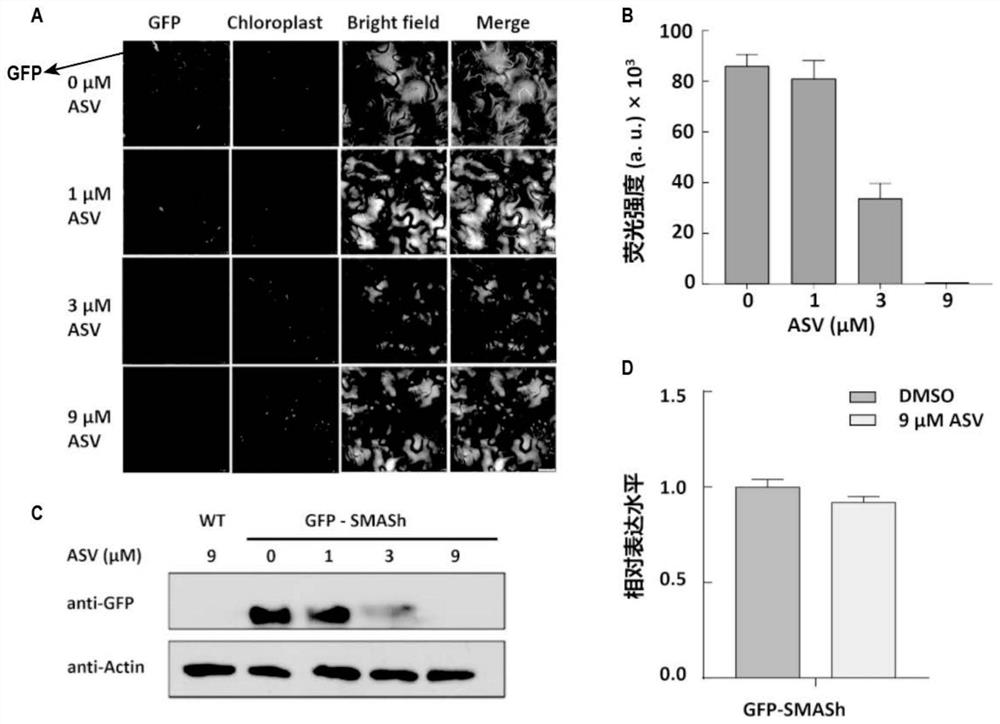Establishment of method for directly reducing protein levels in plants
A plant protein and plant technology, applied in the fields of botanical equipment and methods, biochemical equipment and methods, plant peptides, etc., can solve problems such as the SMASh system that has not been successfully reported, and achieve fine regulation, reversible degradation, and avoidance of lethal appearance. type effect
- Summary
- Abstract
- Description
- Claims
- Application Information
AI Technical Summary
Problems solved by technology
Method used
Image
Examples
Embodiment 1
[0064] Example 1. Use of vegetative SMASh tags to regulate the level of GFP in Arabidopsis
[0065] 1. Construction of vectors
[0066] Codon optimization of the Arabidopsis thaliana virus SMASh tag sequence (entrusted by Beijing Quanshijin Company) to obtain the sequence shown in SEQID NO:28, which was synthesized as a plant SMASh tag coding sequence (entrusted by Beijing Quanshijin Company) .
[0067]By fusion PCR method, the plant SMASh tag coding sequence was combined with the C-terminus of GFP (using primers 5'-AAGAGACAGGATCCACTAGTATGGTGAGCAAGGGCGAGGAG-3' (forward primer, SEQ ID NO: 1), and (5'-GCGGTGGCGGCCGCTCTAGACTAGTACAAAACCTCTATC-3'( Reverse primer, SEQ ID NO: 2)) or N-terminal sequence (use primer 5'-AAGAGACAGGATCCACTAGTATGGATTATAAAGATGATGATGATAAG-3' (forward primer, SEQ ID NO: 29), and (5'-GCGGTGGCGGCCGCTCTAGATTACTTGTACAGCTCGTCCATG-3' (reverse primer ,SEQ ID NO:30)) fusion, through homologous recombination method, using pJL12 binary vector (obtained from Institute...
Embodiment 2
[0095] Example 2. Utilizing plant-based SMASh tags to regulate endogenous gene protein levels in Arabidopsis 1. Construction of vectors and transformation mediated by Agrobacterium
[0096] Using the Arabidopsis genome as a template, using the high-fidelity DNA polymerase FastPfu, (using primers 5'-AAGAGACAGGATCCACTAGTATGGAGGGTTCGTCCAAAGGGCTG-3' (forward primer, SEQ ID NO: 31), and (5'-CCAGATCCACCTCCACTAGTATCAAATTTCACAGTCTCTCCATCGAAAAGACTC-3' (reverse Primer, SEQ ID NO:32)) amplifies an approximately 1.5 kb genomic DNA fragment containing the MYB75 (At1g56650) coding sequence, which does not contain a stop codon at the 3' end of the fragment and adds 3×HA by fusion PCR Tag. By the fusion PCR method, the SMASh sequence (primer 5'-AAGAGACAGGATCCACTAGTATGGAGGGTTCGTCCAAAGGGCG-3' (forward primer, SEQ ID NO: 5) and 5'-CCACTAGTATCAAATTTCACAGTCTCTCCATCGAAAAGACTC-3' (reverse primer, SEQ ID NO: 6)), and cloned into the pJL12 binary expression vector to construct a vector driven by the 3...
Embodiment 3
[0118] Example 3. Combination of plant-based SMASh tags and CRISPR / Cas9 systems
[0119] 1. Construction of vectors
[0120] The rice codon optimization was performed on the AcrIIA4 sequence to obtain the sequence encoding the target protein AcrIIA4 (see SEQ ID NO: 27 for the nucleotide sequence) and synthesize the sequence (Beijing Quanshijin Company), which was passed through the fusion PCR method using primers (5'-CAAAGCTTGTCGACGGATCCATGAACATCAATGACCTCATCAG-3' (forward primer, SEQ ID NO: 15) and 5'-GATTTCAGCGTACCGAATTCCTAGTACAAAACCTCTTCTATCAG-3' (reverse primer, SEQ ID NO: 16)) were fused to the carboxy terminus of the SMASh protein, using the same The method of originating from the same group was cloned into the pJIT163-Ubi-hGFP vector (obtained from the research group of Gao Caixia, Institute of Genetics and Development, Chinese Academy of Sciences, see the vector map Figure 5 ), a vector driven by the Ubi promoter was constructed, and the resulting vector was named Ubi...
PUM
 Login to View More
Login to View More Abstract
Description
Claims
Application Information
 Login to View More
Login to View More - R&D
- Intellectual Property
- Life Sciences
- Materials
- Tech Scout
- Unparalleled Data Quality
- Higher Quality Content
- 60% Fewer Hallucinations
Browse by: Latest US Patents, China's latest patents, Technical Efficacy Thesaurus, Application Domain, Technology Topic, Popular Technical Reports.
© 2025 PatSnap. All rights reserved.Legal|Privacy policy|Modern Slavery Act Transparency Statement|Sitemap|About US| Contact US: help@patsnap.com



